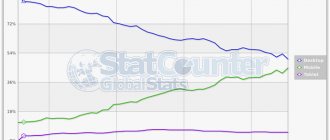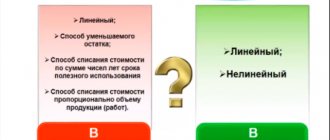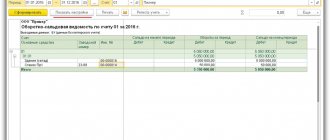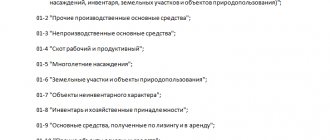What is an OS classifier?
The 2016 classifier of fixed assets used when searching for depreciation groups is provided by the Decree of the Government of the Russian Federation “On the classification of fixed assets included in depreciation groups” dated 02/01/2002 No. 1 with the latest amendments established by the Decree of the Government of the Russian Federation “On amendments to the classification of fixed assets” dated 07/06/2015 No. 674. The classification of depreciation groups is formed according to information from the All-Russian Classifier of Fixed Assets (abbreviated as OKOF) OK 013-94, established by Decree of the State Standard of the Russian Federation dated December 26, 1994 No. 359.
IMPORTANT! From January 1, 2021, the OK 013-2014 classifier, approved by the order of Rosstandart “OK 013-2014 (SNS 2008), begins to function. OKOF" dated December 12, 2014 No. 2018-st. Classifier OK 013-94 will become invalid.
Replacing the old OKOF with a new one will entail reforming the classifier of fixed assets by depreciation groups.
See “The classification of fixed assets by depreciation groups has been updated.”
New classifier in 2021
At the beginning of this year, an updated classifier of property objects began to operate. The main changes affected the encoding of objects. Previously, a nine-digit encoding was used, but now it is a twelve-digit encoding. Some provisions from the old classifier were removed and replaced with generic names.
You can download the OS classifier by depreciation groups for 2021 in the following article.
The new classifier of fixed assets by depreciation groups for 2021 must be used only in relation to the property that the company put into use after January 1 of the current year. That is, if an object was put into use before this time, there is no need to re-establish its depreciation group, even if it has changed.
Especially to ensure that accounting workers do not have any confusion with the new and old coding, Rosstandart has developed a comparative table of old and new codes.
Similar articles
- Classifier of fixed assets by depreciation groups in 2017
- Accrual of depreciation of fixed assets in 2021
- Calculation of depreciation of fixed assets
- Useful life of fixed assets – 2017 classifier
- All-Russian classifier of fixed assets 2021
The principle of constructing depreciation groups of fixed assets of the classifier
The construction of depreciation groups of fixed assets of the classifier is based on establishing the period of effective use of the fixed assets. The classifier presents 10 groups, ranging from OS with a period of application of 1–2 years and ending with OS with a period of application of more than 30 years. Each group contains a detailed list of operating systems indicating their name and encoding, taken from the OKOF directory. Classification using generally established coding greatly facilitates the processing of OS information during their automated recording.
How is the classification of enterprise fixed assets included in depreciation groups made?
Before searching for a depreciation group, they check whether the property belongs to the fixed assets.
Signs of classifying a property object as OS:
- The property is intended to be used in business activities to obtain financial benefits.
- The period of planned use of the object is more than a year.
- There are no plans to resell the property in the near future.
If the property meets all of the above conditions, proceed to the search for a depreciation group. However, according to the classifier established by Decree of the Government of the Russian Federation dated February 1, 2002 No. 1, finding the required OS group is quite difficult and time-consuming, so it is better to initially determine its OS code through the OKOF directory.
Example
Exclusive Photo LLC, which is engaged in the creation and sale of unique photographs, at the beginning of 2021 acquired professional cameras for business activities.
We determine the depreciation group to which the cameras belong. To do this, open the OKOF directory, find the section “Machinery and Equipment” and look at the code for the subsection “Photo and film equipment” - 143322000.
After determining the classification code of cameras, we move on to the classifier established by Decree of the Government of the Russian Federation dated February 1, 2002 No. 1. In this classifier, code 143322000 is included in the 3rd depreciation group of fixed assets (SPI over 3 and up to 5 years). Further, the head of Exclusive Photo LLC, based on the established range, has the right to decide for himself what the depreciation period of the cameras will be.
The considered option for determining depreciation groups is recommended to be used only in the absence of automated accounting in small enterprises with a small number of depreciable objects.
Organizations with a large range of operating systems use programs for automated accounting of business transactions with installed classifiers. The classification of fixed assets by depreciation groups in such cases is carried out automatically when reflecting transactions related to the capitalization of fixed assets, and a specific SPI by category of fixed assets is entered in accordance with the accounting policy approved by the enterprise.
IMPORTANT! In the depreciation groups of fixed assets in 2015, the subsection “Photo and film equipment” was included as a component of the 5th depreciation group (SPI 7–10 years). By Decree of the Government of the Russian Federation dated July 6, 2015 No. 674, this subsection was transferred to the 3rd depreciation group (SPI 3–5 years).
Classification of fixed assets. Types (groups) of fixed assets
The classification of fixed assets is an integral element of organizing property accounting at an enterprise. It helps to specify information about certain objects and solves certain problems of the accounting process and management. Classification of fixed assets involves their grouping according to certain characteristics. For the purposes of accounting, evaluation, and analysis of property objects, six main criteria for classification can be distinguished.
according to natural composition and functions performed (by type) - standard classification. In accordance with the All-Russian Classifier of Fixed Assets (OK 013-94), approved by Decree of the State Standard of Russia dated December 26, 1994 No. 359 (hereinafter referred to as OKOF), fixed assets are accounted for in the following groups (Table 1).
Table 1 – Classification of fixed assets by type
| Group name | Code | Composition of the group |
| Buildings (except residential) | 11 0000000 | Buildings of workshops, factory management, workshops, etc. The object of classification in this group is considered to be each separate building or extension if it has independent economic significance (warehouse, garage) along with all communications (lighting, heating, ventilation, water and gas supply, elevator household, internal telephones, etc.) ensuring normal operation |
| Facilities | 12 0000000 | Oil and gas wells, bridges, overpasses, roads, mines, sewers, gates, cylinders and tanks, etc. are engineering and construction objects designed to create the conditions necessary for the performance of certain functions in the production process. The classification object is a separate building with all devices |
| Dwellings | 13 0000000 | Panel houses, buildings and other premises used for housing, historical monuments related to residential buildings |
| cars and equipment | 14 0000000 | — Energy equipment (nuclear reactors, steam engines, turbines, internal combustion engines, etc.), which either produce electricity or thermal energy, or convert it into mechanical energy of movement. The object of classification is each individual machine (if it is not part of another object), including its constituent fixtures, accessories, instruments, individual fencing, foundation; — Working machines and equipment (machines, machines, devices) for mechanical, thermal and chemical effects on the object being processed. The object of classification of working machines and equipment is each individual machine, apparatus, unit, installation, etc., including their included accessories, instruments, tools, electrical equipment, individual fencing, foundation; — Measurement and control equipment (scales, pressure gauges, equipment for remote control, alarms, instruments and laboratory equipment, etc., which are designed to measure various parameters of equipment operation, check the quality of materials, raw materials, finished products, etc.) ; — Communication systems equipment; — Computer equipment, office equipment. Object - each machine, equipped with all devices and accessories necessary to perform the functions assigned to it, and not being an integral part of any other machine; — Other machines and equipment not included in the above groups (fire engines, automatic telephone exchange equipment). |
| Means of transport | 15 0000000 | Vehicles for people and various cargo (locomotives, wagons, ships, ships, trucks and cars, buses, airplanes, helicopters, etc.). The object of classification is each individual object with all its accessories and accessories. |
| Industrial and household equipment | 16 0000000 | Electric drills, vibrators, jackhammers, workbenches, containers, inventory containers, etc., which are used either to facilitate manual labor or to attach to machines to enhance their power. Classification objects can only be objects that have an independent purpose and are not part of any other object |
| Working, productive and breeding livestock (except for young animals and livestock for slaughter) | 17 0000000 | Horses, oxen, camels, donkeys and other working animals (including transport horses); cows, sheep, as well as other animals, etc. The object of classification is every adult animal, except livestock for slaughter |
| Perennial plantings | 18 0000000 | Trees and shrubs, hedges, landscaping and decorative plantings on streets, squares, parks, gardens, squares, etc. The objects of classification are the green spaces of each park, garden, square, street, boulevard, yard, enterprise territory, etc. . in general, regardless of the number, age and species of plantings |
| Material fixed assets not included in other groups | 19 0000000 | Library collections, capital expenditures for land improvement (reclamation, drainage, irrigation and other works) |
The classification of fixed assets according to their physical nature is the basis of their analytical accounting. Grouping of property objects in the OKOF classifier is carried out by assigning codes, the structure of which is built according to the following scheme:
- X0 0000000 – section;
- XX 0000000 – subsection;
- XX XXXX000 – class;
- XX XXXX0XX – subclass;
- XX XXXXXXXX – view.
Each position presented in OKOF has its own nine-digit decimal digital code (OKOF code), control number (CN) and name. The classification division of objects to the level of subclasses is carried out according to a hierarchical principle. At the very last level of classification - types, facets, or lists, are used that are linked to the lower level of the hierarchical structure - subclasses.
According to OKOF, fixed assets do not include:
- items that last less than one year, regardless of their value;
- items valued below the limit established by the Ministry of Finance of Russia (less than 40,00 rubles), regardless of their service life, with the exception of agricultural machinery and tools, construction mechanized tools, weapons, as well as working and productive livestock, which are classified as fixed assets, regardless of their cost;
- fishing gear (trawls, seines, nets, nets and other fishing gear) regardless of their cost and service life;
- gasoline-powered saws, delimbers, floating cable, seasonal roads, mustaches and temporary branches of logging roads, temporary buildings in the forest with a service life of up to two years (mobile heating houses, boiler stations, pilot workshops, gas stations, etc.);
- special tools and special devices (tools and devices for special purposes, intended for serial and mass production of certain products or for the manufacture of individual orders), regardless of their cost;
- replaceable equipment, devices for fixed assets that are repeatedly used in production and other devices caused by specific manufacturing conditions - molds and accessories for them, rolling rolls, air lances, shuttles, catalysts and sorbents of a solid state of aggregation, etc., regardless of their cost;
- special clothing, special shoes, as well as bedding, regardless of their cost and service life;
- uniforms intended for issue to employees of an enterprise, clothing and footwear in healthcare, education, social security and other institutions funded by the budget, regardless of cost and service life;
- temporary structures, fixtures and devices, the construction costs of which are included in the cost of construction and installation work as part of overhead costs;
- containers for storing inventory in warehouses or carrying out technological processes, costing within the limit established by the Ministry of Finance of Russia;
- items intended for rental, regardless of their value;
- young animals and fattening animals, poultry, rabbits, fur-bearing animals, bee families, as well as sled and guard dogs, experimental animals;
- perennial plants grown in nurseries as planting material;
- machines and equipment listed as finished products in the warehouses of manufacturing enterprises, supply and sales organizations, handed over for installation or to be installed, in transit, listed on the balance sheet of capital construction.
Reference. In accordance with the Order of Rosstandart dated December 12, 2014 No. 2018-st, the All-Russian Classifier of Fixed Assets OKOF OK 013-94 should have been canceled from January 1, 2021. However, its validity was extended for another year (Order of Rosstandart dated November 10, 2015 No. 1746-st). The new OKOF OK 013-2014 (SNS 2018) is planned to be used from January 1, 2021.
according to useful life. Based on the OKOF classification codes, a list of 10 depreciation groups has been developed, which is approved by Decree of the Government of the Russian Federation dated January 1, 2002 No. 1 “On the classification of fixed assets included in depreciation groups.” This document is used mainly for grouping depreciable property, determining its useful life (SPI) and calculating depreciation amounts for the purpose of calculating income tax. However, clause 1 of the Decree of the Government of the Russian Federation dated January 1, 2002 No. 1 establishes that this classification can also be used for accounting purposes. Table 2 presents a list of depreciation groups into which fixed assets are combined.
Table 2 – Classification of fixed assets by useful life
| Group number | Useful life | Composition of the group |
| 1 | From 1 to 2 years inclusive | - Cars and equipment |
| 2 | Over 2 to 3 years inclusive | - Cars and equipment; — Industrial and household equipment; — Perennial plantings. |
| 3 | Over 3 to 5 years inclusive | — Structures and transmission devices; - Cars and equipment; — Means of transport; — Industrial and household equipment; — Fixed assets not included in other groups. |
| 4 | Over 5 to 7 years inclusive | - Building; — Structures and transmission devices; - Cars and equipment; — Means of transport; — Industrial and household equipment; — Working cattle; — Perennial plantings. |
| 5 | Over 7 to 10 years inclusive | - Building; — Structures and transmission devices; - Cars and equipment; — Means of transport; — Industrial and household equipment; — Perennial plantings; — Fixed assets not included in other groups. |
| 6 | Over 10 to 15 years inclusive | — Structures and transmission devices; - Dwellings; - Cars and equipment; — Means of transport; — Industrial and household equipment; — Perennial plantings. |
| 7 | Over 15 to 20 years inclusive | - Building; — Structures and transmission devices; - Cars and equipment; — Means of transport; — Perennial plantings; — Fixed assets not included in other groups. |
| 8 | Over 20 to 25 years inclusive | - Building; — Structures and transmission devices; - Cars and equipment; — Means of transport; — Industrial and household equipment. |
| 9 | Over 25 to 30 years inclusive | - Building; — Structures and transmission devices; - Cars and equipment; — Means of transport. |
| 10 | Over 30 years | - Building; — Structures and transmission devices; - Dwellings; - Cars and equipment; — Means of transport; — Perennial plantings. |
According to the degree of use in the organization’s activities , fixed assets are allocated:
- in operation;
- in stock (reserve);
- under repair;
- at the stage of completion, additional equipment, reconstruction, modernization and partial liquidation;
- on conservation.
According to the ownership of the owner on the basis of the rights of the organization, fixed assets are divided into:
- own;
- rented (obtained on lease);
- under operational management or economic control;
- received for free use;
- received in trust.
According to their functional purpose, fixed assets can be:
- production Production fixed assets include objects that are used in the normal activities of the organization, i.e. in production, construction, trade, etc.;
- non-productive. Non-productive fixed assets include objects that are not used in the normal activities of the organization. These are housing and communal services, scientific, cultural, healthcare institutions, etc.
By the nature of participation in the production process, fixed assets are divided into:
- active - fixed assets that directly affect the subject of labor and affect production;
- passive - fixed assets that provide conditions for the normal flow of the production process.
Other types of classifications of fixed assets are based on the following grouping characteristics:
According to industry, fixed assets are distinguished:
- industry;
- Agriculture;
- trade;
- communications;
- transport;
- construction, etc.
By type of ownership, fixed assets can be grouped into groups:
- government;
- private;
- collective;
- foreign, etc.
Based on material characteristics, fixed assets are distinguished:
- inventory – objects that have a material form and can be verified (measured, counted): buildings, structures, machines, equipment, etc.;
- non-inventory - objects are formed from costs and do not have material content (for example, capital investments in leased fixed assets).
Based on duration of operation or age composition (not to be confused with useful life), fixed assets are classified into groups:
- up to 5 years;
- from 5 to 10 years;
- from 10 to 15 years;
- from 15 to 20 years;
- over 20 years.
by region. If an organization has its divisions in regions of the country (and beyond), then fixed assets can be divided into the corresponding regions (and countries).
Based on physical wear and tear, property objects are distributed into groups, each of which the organization sets a percentage (%) of physical wear and tear. For example, up to 15%, 16 – 40%, 41 – 60%, 61 – 80%, 81 – 100%.
by obsolescence: a grouping technique similar to grouping by physical wear and tear.
According to the technical level, fixed assets can be divided into:
- backward objects;
- ordinary objects;
- advanced facilities, etc.
by time of use. There may be several classification options depending on the specific management needs of the organization. For example, from the total number of objects we can distinguish those that are used in 1 shift, in 2 shifts, in 3 shifts. Or distribute fixed assets among those used during the year: up to 150 hours per year, 151 – 300 hours per year, 301 – 450 hours per year, etc.
Similar articles:
Fixed assets → Concept of fixed assets
Features of accounting for 1st and 2nd depreciation groups of fixed assets
According to the provisions established by the Law “On Amendments to the Tax Code of the Russian Federation” dated November 24, 2014 No. 366-FZ for fixed assets belonging to the 1st and 2nd depreciation groups, from the beginning of 2015 property tax is not calculated (subclause 8 Clause 4 of Article 374 of the Tax Code of the Russian Federation).
IMPORTANT! Movable fixed assets, taken into account by the taxpayer from January 1, 2013, from the category of non-taxable fixed assets, from the beginning of 2015, were transferred to the category of preferential fixed assets, exempt from taxation (clause 25 of article 381 of the Tax Code of the Russian Federation). This category includes all movable fixed assets belonging to depreciation groups 3–10.
For more information about preferential fixed assets exempt from tax calculation, read the article “Tax benefit codes for property tax - 2010257”.
Example (continued)
In the same year, Exclusive Photo LLC acquired personal computers (abbreviated as PCs) for photo processing. According to the classifier, PCs belong to the item “Electronic computer equipment” with code 143020000, which is part of the 2nd depreciation group.
When calculating property tax, the cost of a PC is not included in the tax base and is recorded in the declaration for this tax in section. 2 consisting of pages 170 and 270.
Professional cameras that are movable fixed assets (clause 2 of Article 130 of the Civil Code of the Russian Federation), acquired after the beginning of 2013, are classified as preferential fixed assets, the cost of which is not included in the tax base for property tax. In the property tax return, the residual value of professional cameras is displayed in section. 2 in gr. 4 on pp. 20–140 and as part of pp. 170 and 270.
For aspects of reflecting non-taxable fixed assets in the personal income tax return, see the article “Nuances of filling out a property tax return.”
About useful life
For tax accounting purposes, the useful life is determined by the taxpayer independently on the date of commissioning of this depreciable property in accordance with the provisions of Art. 258 and taking into account the Classification of fixed assets, approved by Decree of the Government of the Russian Federation of 01.01.2002 N 1. In it, fixed assets are distributed into ten depreciation groups, the fixed assets included in each group and the corresponding OKOF codes are listed.
In this case, the taxpayer has the right to increase the useful life of an asset after the date of its commissioning if, after reconstruction, modernization or technical re-equipment of such an object, its useful life has increased. An increase in the period can be carried out within the time limits established by the Classification of fixed assets for the depreciation group in which this fixed asset is included (Letter of the Ministry of Finance of Russia dated July 6, 2016 N 03-05-05-01/39563).
Other cases of changing the useful life of an asset previously put into operation (transfer from one depreciation group to another) are not provided for by the provisions of the Tax Code.





